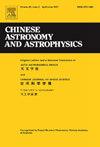用于精确时标计算的光钟和氢脉泽的组合
Q4 Physics and Astronomy
引用次数: 0
摘要
光钟的频率稳定性和不确定度已达到10−18量级,使其成为下一代时间和频率标准的有希望的候选者,并可用于重新定义国际单位“秒”。时间标度是准确连续标记时间流逝的基准,是高精度时间生成的基础。时间标度的产生依赖于原子钟连续稳定的运行;然而,光钟作为实验室原型器件,通常不能连续工作,因此将光钟纳入时标计算是一个具有挑战性的问题。提出将vondrake - cepek组合滤波算法应用于光钟和氢脉泽的联合时标计算,旨在解决光钟间歇性运行带来的挑战。首先,利用ALGOS算法对氢脉泽的时差数据进行计算,得到连续稳定的氢脉泽时钟时标。随后,采用Vondrak-Cepek联合滤波算法对氢脉射时标和光钟数据进行积分,得到包含光钟的组合时标。最后,实验结果证明,Vondrak-Cepek联合滤波算法有效地提高了光钟和氢脉泽联合时标的性能,与协调世界时(UTC)相比,该时标的时间偏差达到亚纳秒量级。本文章由计算机程序翻译,如有差异,请以英文原文为准。
Combination of an Optical Clock and Hydrogen Masers for Accurate Time Scale Calculation
The frequency stability and uncertainty of the optical clock have reached a magnitude of , making it a promising candidate for the next generation of time and frequency standards, and it may be used to redefine the international unit “second”. The time scale serves as a benchmark for accurately and continuously marking the passage of time, being the foundation of high-precision time generation. The production of a time scale relies on the continuous and stable operation of atomic clocks; however, optical clocks, as laboratory prototype devices, generally cannot operate continuously, thus involving optical clocks in time scale calculation presents a challenging issue. The proposed application of the Vondrak-Cepek combined filtering algorithm for joint time scale calculations with an optical clock and hydrogen masers aims to address the challenges posed by the intermittent operation of an optical clock. Initially, the ALGOS algorithm is used on the time difference data of the hydrogen masers to calculate and obtain a continuous and stable hydrogen maser clock time scale. Subsequently, the Vondrak-Cepek combined filtering algorithm is used to integrate the hydrogen maser time scale with the optical clock data to acquire a combined time scale that involves optical clocks in the calculation. Finally, the experimental results prove that the Vondrak-Cepek combined filtering algorithm effectively improves the performance of the combined time scale of optical clocks and hydrogen masers, with the time deviation of this time scale reaching the sub-nanosecond magnitude when compared with Coordinated Universal Time (UTC).
求助全文
通过发布文献求助,成功后即可免费获取论文全文。
去求助
来源期刊

Chinese Astronomy and Astrophysics
Physics and Astronomy-Astronomy and Astrophysics
CiteScore
0.70
自引率
0.00%
发文量
20
期刊介绍:
The vigorous growth of astronomical and astrophysical science in China led to an increase in papers on astrophysics which Acta Astronomica Sinica could no longer absorb. Translations of papers from two new journals the Chinese Journal of Space Science and Acta Astrophysica Sinica are added to the translation of Acta Astronomica Sinica to form the new journal Chinese Astronomy and Astrophysics. Chinese Astronomy and Astrophysics brings English translations of notable articles to astronomers and astrophysicists outside China.
 求助内容:
求助内容: 应助结果提醒方式:
应助结果提醒方式:


